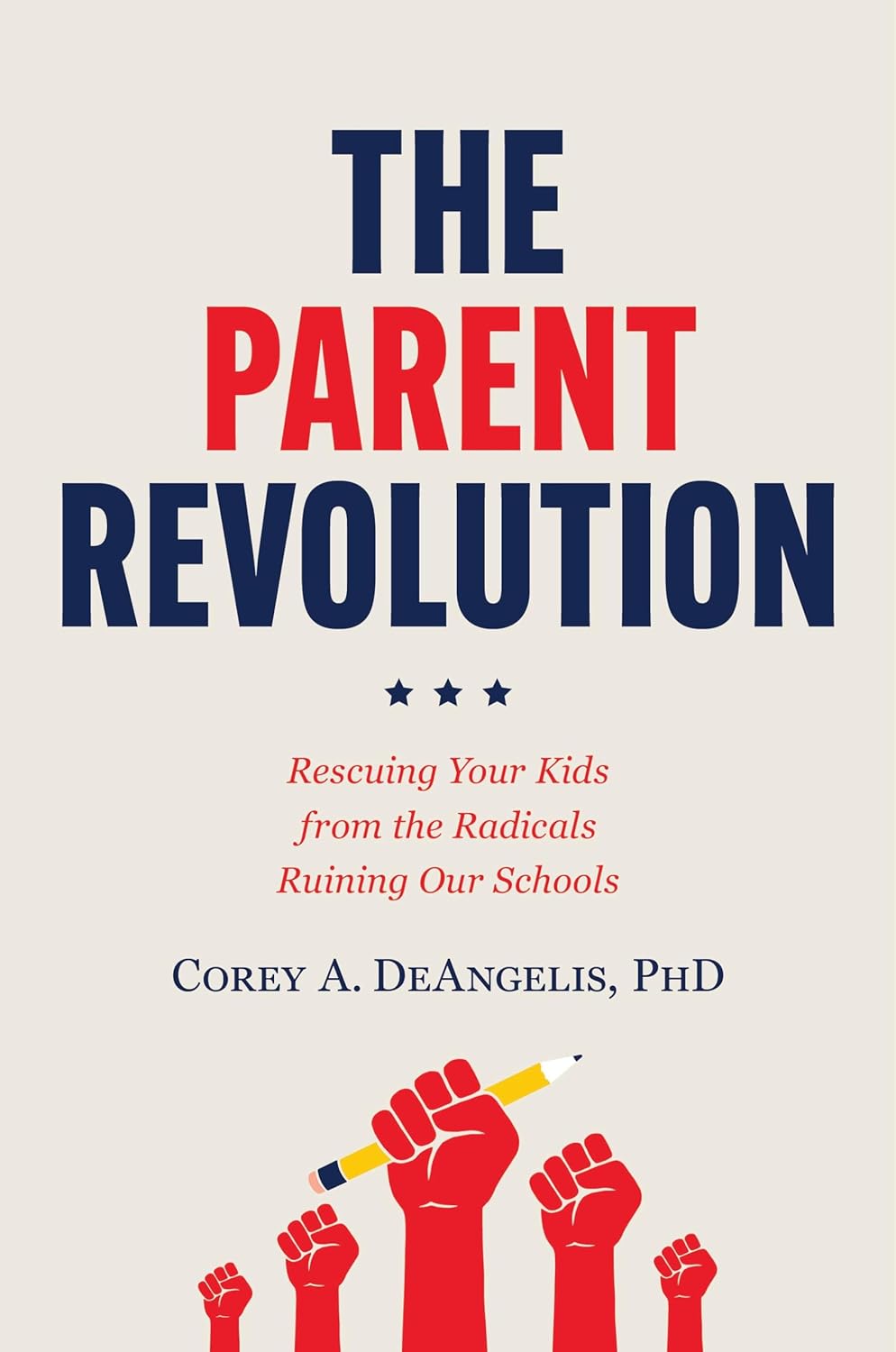Public schools have been failing for years. Despite ample resources, students increasingly can’t read, write, or do arithmetic at grade level. Yet communities remained supportive of their public schools—until the COVID-19 years. Neither the length of school closures nor the resulting learning losses were a tragic necessity forced upon the education system by the pandemic. Instead, these were the direct results of policy choices that put teachers unions and their political allies first, and students and parents last.
This was a wakeup call. Parents heard it loud and clear.
Corey DeAngelis, arguably the nation’s leading advocate for K–12 education reform, has an answer: universal school choice. In his important new book, The Parent Revolution, DeAngelis documents how teachers unions’ overreach caused a blowback that propelled the education freedom movement to national prominence. Four years after COVID, school choice has seen phenomenal successes, with more surely to come. DeAngelis tells the story of this growing support for school choice and shows how to keep the momentum going.
School choice refers to several proposals that make public education funding transferable so that parents get to decide how their taxes are spent on their children’s education. The best-known option is vouchers: students can take their government allotment of education dollars and spend it on tuition at private schools. The policy DeAngelis prefers is education savings accounts (ESAs), which he prefers over vouchers because they allow parents more options: “Families can use ESAs for private school tuition, tutoring, textbooks, homeschool curriculum, online courses, special-needs therapy, and more.” Since government financing for K-12 education isn’t going away, he argues, its programs should give parents a wide scope to choose how that money is spent.
DeAngelis, who holds a Ph.D. in education policy from the University of Arkansas, is a self-described “school choice evangelist” with an impressive record writing on the issue in academic and journalistic outlets. He has amassed a large following on Twitter (now X) for calling out legislators who vote against school choice while sending their own kids to private school. And he has spoken publicly in every state that has successfully embraced school choice, as well as in many states that are on the cusp. DeAngelis has played an important role in turning this issue from a marginal one mostly of interest to conservative policy wonks into a non-negotiable position for Republican politicians who purport to take education seriously, and everyone interested in reforming education should pay careful attention to his experiences.
Right from the start, DeAngelis comes out swinging. He links the surging popularity of school choice to teachers unions’ support for burdensome public school closures during the COVID years: “Parents haven’t forgotten how powerless they suddenly felt in 2020. Power-hungry teachers unions finally overplayed their hand and sparked a parent revolution.” He documents teachers unions’ post-pandemic attempts to downplay their role in promoting and sustaining closures and deny the very existence of learning loss.
Parents were initially supportive of the public schools’ policies, recognizing the challenges of coping with a once-in-a-lifetime public health emergency. But after seeing private schools reopening safely, and confronted with public school officials’ demands for financial resources and other desired outcomes totally unrelated to public health (“police-free schools,” “canceling rents and mortgages,” and “a moratorium on new charter and voucher programs,” to name a few), they lost their patience and started fighting back. They voiced their concern at school board meetings. They made it clear to their elected officials that they would not tolerate public school officials’ dismissing and ignoring them. And they sued to reopen schools. In response, teachers unions vilified parents.
So parents did exactly what you’d expect: they exercised their exit rights, sending their kids to Catholic and other private schools or experimenting with microschools and learning pods. “By the fall of 2021, public school enrollment nationwide was down by more than 1.5 million students,” DeAngelis notes. Teachers unions and their political allies tried to quash the exodus by closing alternatives to public schools, with little success.
While it is a good thing that so many parents could protect their children from the failures of the public school system, not everyone was so fortunate. DeAngelis thinks school choice would give options for many more children. This is why funding should follow the student with ESAs, he argues: “Fund students, not systems.”
The deeper failures of the public school system become even more apparent as the misery of Zoom kindergarten fades in parents’ memory. Public schools’ curricula are increasingly ideological, rather than instructive. And they’re not even truly public, DeAngelis argues: these schools are generally restricted by residential location; the services they provide are not unique or essential (as demonstrated by the viable options of private schools and homeschooling); they falsely claim that the government should provide education for all instead of merely funding it, including coercing members of the public who prefer alternatives; and school-board elections provide very weak accountability, at best, for parents, for whom feasible schooling alternatives are very costly. Government schooling is not a public benefit but an unjust monopoly on American education.
Yet their grip on that monopoly continues to slip. School choice provides important competitive pressure that the existing system lacks and makes education truly accessible and accountable. This is not merely a theoretical conjecture. DeAngelis cites plenty of scholarly evidence showing that school choice is good for students. A healthy majority of studies show improved student learning outcomes (better test scores, higher graduation rates, and more). Many studies also show that school choice saves taxpayers money: even if only a fraction of students’ public education dollars are made transferable, families can use that money to pursue better outcomes than they could get from the public school system. The scholarly evidence clearly shows that school choice works.
And the public is listening. Except among diehard progressives, school choice is overwhelmingly popular. DeAngelis calls for a “red state strategy” to expand educational freedom: he wants school choice to become a litmus test for Republican politicians. (It’s a sad irony that outreach to Democrats has proved disappointing, since Democrats frequently claim to be defenders of the underprivileged, and it is the underprivileged who suffer most from bad public schools.)
Promoters of school choice, riding an unprecedented wave of public support, saw major policy gains in 2021. West Virginia’s case is particularly instructive: the Mountain State’s Hope Scholarships became “the nation’s first publicly funded education choice policy for all students.” DeAngelis narrates a sweeping tale, ranging from the state government’s capitulation in the face of teacher strikes to major education reform just years later. Throughout it all, DeAngelis was there, digitally and often physically. His tales of duels with teachers union officials on X and well-attended rallies in support of school choice make readers feel like they are watching the birth of a political movement in real time.
While 2021 was impressive, 2023 was the true banner year for school choice. The most encouraging results had to do with ESAs. Four states—Iowa, Utah, Arkansas, and Florida—implemented universal school choice programs. As the American Enterprise Institute’s Max Eden put it, school choice saw more progress “in the first half of 2023 than it made in the preceding 23 years.”
DeAngelis’s perspective on the Lone Star State is an interesting case study. Texas has long been an anti–school choice holdout due to the misguided fears of rural Republicans who worry that school choice will harm rural schools, which can least afford to lose students and their associated government funding. Of course, this is an exaggeration. Precisely because rural areas are sparsely populated, the market for private education alternatives is not big enough to threaten public schools. Some families will likely choose to homeschool their kids who could not previously afford to do so, but not enough to threaten the integrity of the system. For rural schools, life will continue as usual—both in the classroom and come time for Friday night lights.
Governor Greg Abbott was aware of all this, and he pushed hard for education freedom and parents’ rights in 2023. His legislative agenda initially stalled but—and this moves beyond the time frame of DeAngelis’s book—his efforts to take out anti–school choice Republicans in the 2024 primary election were surprisingly successful. The prospects for a universal school choice bill in Texas’s 2025 legislative session are bright.
DeAngelis concludes his book with a multipronged strategy to keep the momentum going. He recommends parents keep up the pressure on local school boards, demand transparent and accountable curricula, and make their voices heard in state capitals. “Not long ago, the idea that we should fund students, not systems, was considered radical and fringe,” DeAngelis reminds us. Now it’s solidly in the mainstream. He urges parents and politicians to keep going.
Nearly seventy years ago, the economist and Nobel laureate Milton Friedman proposed making education funding transferable. Back then, no one listened. Now, thanks to teachers unions’ malfeasance and parental engagement, school choice is coming like an avalanche. DeAngelis is a key figure in the once-in-a-generation opportunity to place a high-quality education within the reach of all children, regardless of their parents’ economic status. His book is both an entertaining narrative and hard-nosed manual for how to fight and win. The goal is nothing less than “universal education choice in all 50 states.” It’s a tremendously ambitious goal, and a worthy one.
















